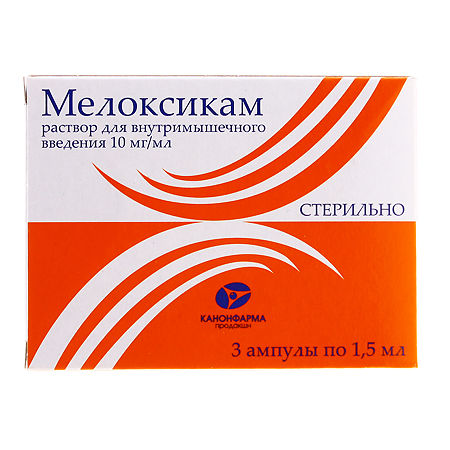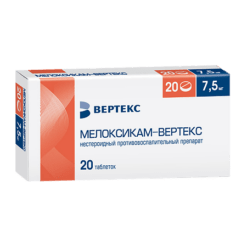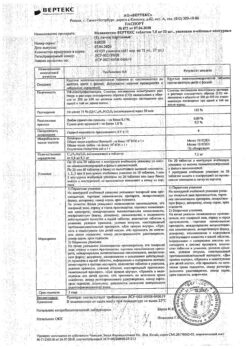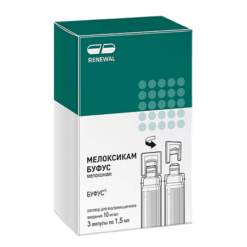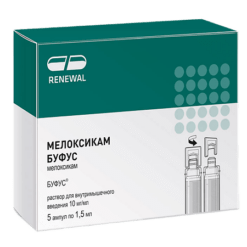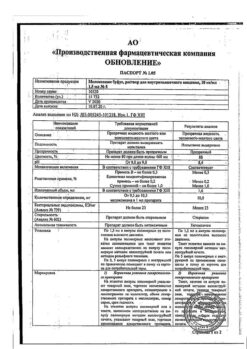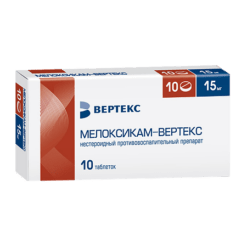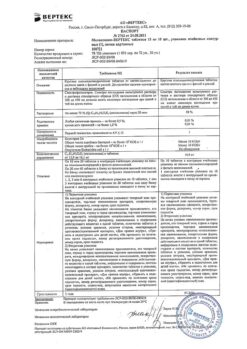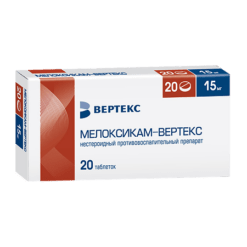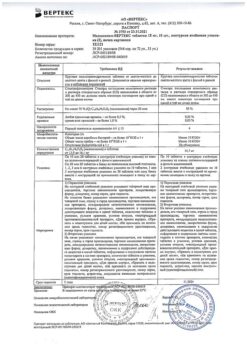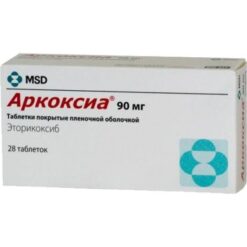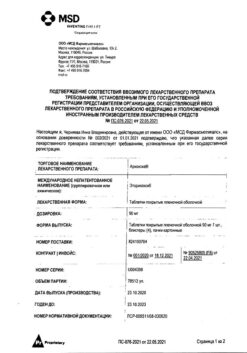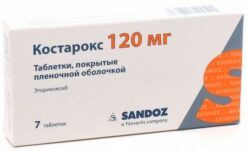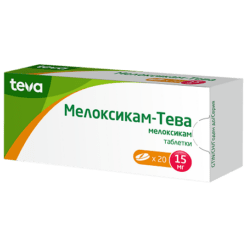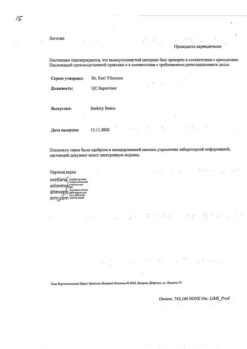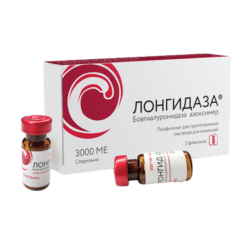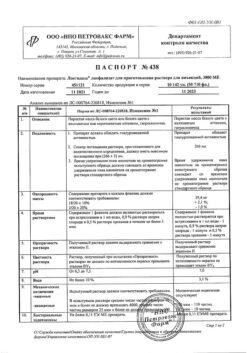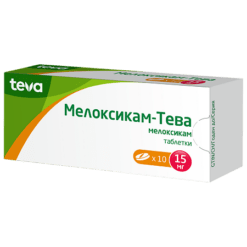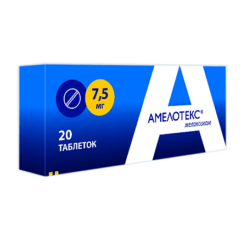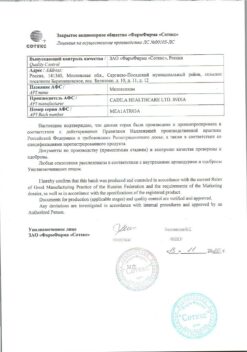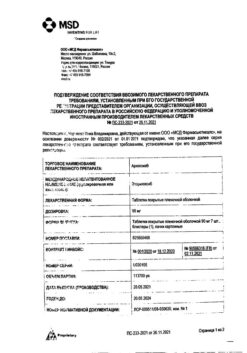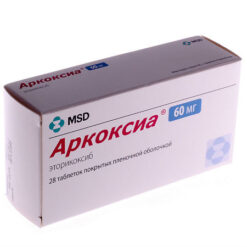No products in the cart.
Meloxicam, 10 mg/ml 1.5 ml 3 pcs
€1.00
Out of stock
(E-mail when Stock is available)
Description
NSAID, has anti-inflammatory, antipyretic, analgesic effects. It belongs to the class of oxycams; a derivative of enolic acid.
Method of action – inhibition of Pg synthesis due to selective suppression of COX2 enzymatic activity.
When administered in high doses, prolonged use and individual characteristics of the COX2 selectivity decreases.
Suppresses Pg synthesis in the area of inflammation to a greater extent than in the gastric mucosa or kidneys, which is due to the relatively selective inhibition of COX2.
Rarely causes gastrointestinal erosive and ulcerative diseases.
Indications
Indications
Rheumatoid arthritis; osteoarthritis; ankylosing spondylitis (Behterev’s disease) and other inflammatory and degenerative joint diseases accompanied by pain syndrome.
It is intended for symptomatic therapy, reduction of pain and inflammation at the time of use, does not affect the progression of the disease.
Active ingredient
Active ingredient
Composition
Composition
Active substance:
meloxicam 15 mg;
Associates:
glycine (aminoacetic acid),
macrogol (polyethylene glycol 400),
p> meglumine (N-methyl-D-glucamine),
povidone-K 17 (plasdon C-15 or collidone 17 F),
1.2 – propylene glycol,
sodium hydroxide,
water for injection
How to take, the dosage
How to take, the dosage
Intramuscular administration of Meloxicam is reasonable during the first 2-3 days of treatment. Thereafter, the drug should be switched to oral administration.
The maximum recommended daily dose should not exceed 15 mg.
Interaction
Interaction
When concomitantly administered with other. NSAIDs increases the risk of gastrointestinal ulcers and gastrointestinal bleeding;
increases the concentration of Li+ in plasma when used simultaneously with Li+ preparations; reduces the effectiveness of ICE, hypotensive drugs;
indirect anticoagulants, ticlopidine, heparin, thrombolytics increase the risk of bleeding;
Methotrexate increases myelodepressant effects;
Diuretics increase the risk of renal dysfunction;
Cyclosporine increases nephrotoxic effects; colestyramine accelerates excretion.
Myelotoxic drugs increase manifestations of hematotoxicity of the drug.
Special Instructions
Special Instructions
In case of peptic ulcers or gastrointestinal bleeding, development of skin and mucous membrane side effects, the drug should be discontinued.
In patients with decreased RBC and glomerular filtration (dehydration, CHF, cirrhosis, nephrotic syndrome, clinically manifested renal disease, use of diuretics, dehydration after major surgery) there may be clinically manifested CPN which is completely reversible after discontinuation of the drug (daily urine output and renal function should be monitored in such patients at the beginning of treatment). In case of steady and significant increase of transaminases and changes of other liver function parameters the drug should be discontinued and control tests should be performed.
In patients with increased risk of side effects, treatment should be started with 7.5 mg. In terminally ill CKD patients on dialysis, the dose should not exceed 7.5 mg/day.
When taking this therapy it is necessary to be cautious about driving vehicles and other potentially dangerous activities which require high concentration and quick psychomotor reactions (if dizziness and somnolence occur). To decrease the risk of gastrointestinal side effects it is necessary to use the minimal effective dose with the shortest possible course.
Contraindications
Contraindications
Hypersensitivity (including. to other NSAIDs), “aspirin” triad (combination of bronchial asthma, recurrent nasal and paranasal sinus polyposis and intolerance to acetylsalicylic acid and pyrazolone-based drugs), gastric and duodenal ulcer in the acute stage; gastrointestinal, cerebrovascular or other bleeding; severe heart failure, severe hepatic failure, severe renal failure (if hemodialysis is not carried out), pregnancy, lactation, age less than 15 years.
Side effects
Side effects
Gastrointestinal organs: dyspepsia, nausea, vomiting, abdominal pain, constipation/diarrhea, flatulence; stomatitis, transient changes in liver function parameters (increased levels of transaminases or bilirubin), belching, esophagitis, stomach and duodenal ulcers, hidden or macroscopically visible gastrointestinal bleeding;
Nervous system and sensory organs: Headache, dizziness; vertigo, drowsiness, tinnitus;
Cardiovascular system and blood (hematopoiesis, hemostasis): edema, anemia; increased BP, palpitations, blood flushes to the face, hemogram changes, including.including changes in the number of certain types of leukocytes, leukopenia, thrombocytopenia.
Respiratory system disorders: exacerbation of bronchial asthma, cough.
Urinary system disorders: changes in renal function parameters (increased blood creatinine and/or urea levels);
Skin disorders: skin rash, itching; urticaria;
Similarities
Similarities
Additional information
| Weight | 0.020 kg |
|---|---|
| Shelf life | 3 years |
| Conditions of storage | In a dry, light-protected place at a temperature not exceeding 25 °C. |
| Manufacturer | Kanonfarma Production ZAO, Russia |
| Medication form | solution |
| Brand | Kanonfarma Production ZAO |
Other forms…
Related products
Buy Meloxicam, 10 mg/ml 1.5 ml 3 pcs with delivery to USA, UK, Europe and over 120 other countries.

